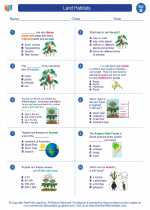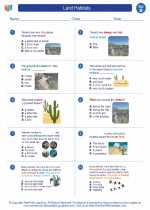Land Habitats
Land habitats are the different types of environments that can be found on land, such as deserts, forests, grasslands, and mountains. Each of these habitats has specific characteristics that make them unique and support a variety of plant and animal life.
Desert Habitats
Deserts are dry, arid environments with very little rainfall. They are characterized by extreme temperatures, sparse vegetation, and unique animal adaptations such as the ability to store water and withstand heat. Some common desert animals include camels, snakes, and lizards.
Forest Habitats
Forests are dense, wooded areas with abundant plant and animal life. They can be further classified into tropical, temperate, and boreal forests based on their location and climate. Forests are home to a wide variety of species, including trees, birds, mammals, and insects.
Grassland Habitats
Grasslands are open, grassy areas with few trees. They are known for their rich soil and are often used for agriculture. Grasslands support a diverse range of wildlife, including grazing animals like buffalo and antelope, as well as predators like lions and wolves.
Mountain Habitats
Mountains are characterized by high altitude, steep slopes, and diverse climatic conditions. They are home to a wide range of plant and animal species, some of which are adapted to the harsh mountain environment. Mountain habitats can include alpine meadows, snow-capped peaks, and rocky slopes.
Study Guide
- What are the characteristics of desert habitats?
- Describe the different types of forests and their unique features.
- How do grassland habitats support a diverse range of wildlife?
- What are some of the challenges faced by animals living in mountain habitats?
- Discuss the importance of preserving and protecting land habitats.
By understanding the characteristics and importance of different land habitats, we can appreciate the diversity of life on Earth and work towards preserving these environments for future generations.
.◂Science Worksheets and Study Guides Second Grade. Land Habitats

 Activity Lesson
Activity Lesson
 Worksheet/Answer key
Worksheet/Answer key
 Worksheet/Answer key
Worksheet/Answer key
 Worksheet/Answer key
Worksheet/Answer key
 Worksheet/Answer key
Worksheet/Answer key
 Vocabulary/Answer key
Vocabulary/Answer key
 Vocabulary/Answer key
Vocabulary/Answer key
